The Washington, D.C. institution is researching dozens of works in its collection as it starts the process of returning them to Nigeria.
Taylor Dafoe, November 5, 2021
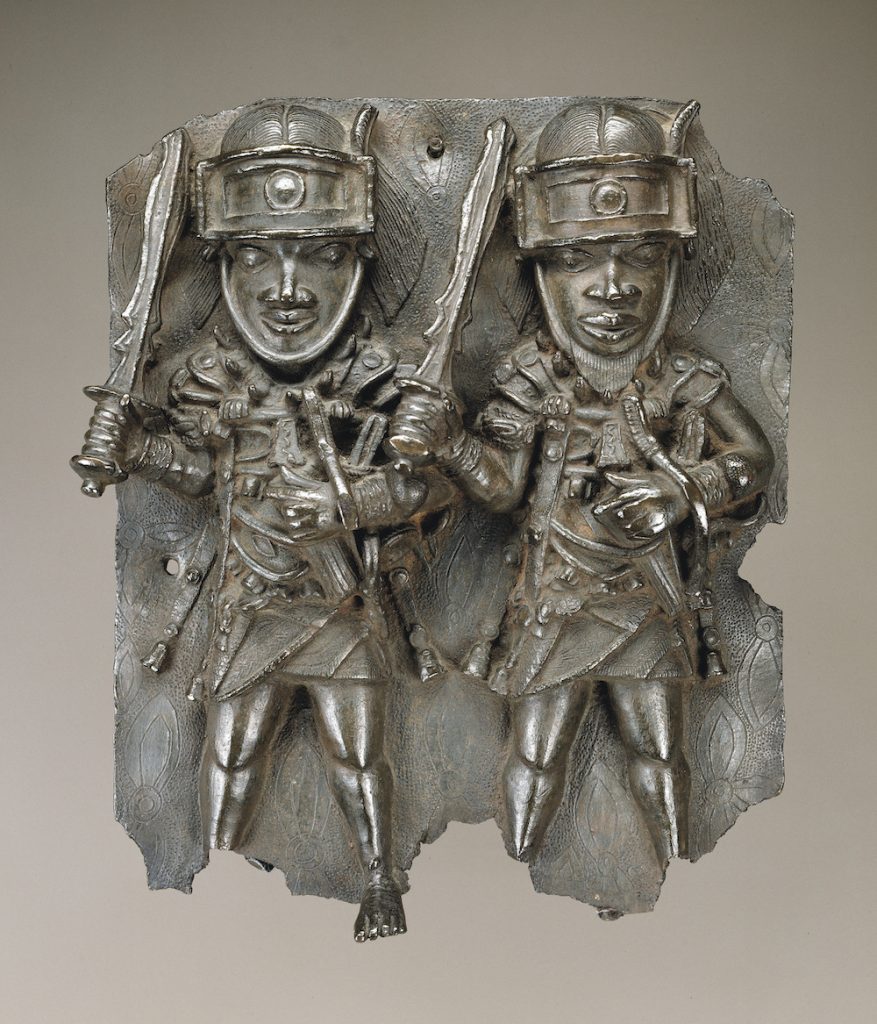
A Benin plaque from the mid-16th to 17th centuries.
Courtesy of the National Museum of African Art.
In a sign of changing priorities, the Smithsonian Institution’s National Museum of African Art (NMAFA) in Washington, D.C., has removed 10 Benin bronzes from public view as it looks into returning the objects to Nigeria.
The decision came directly from the museum’s newly-hired director, Ngaire Blankenberg, late last month—just 11 days after she moved to Washington, D.C. for the post. The bronzes taken down from display are among 16 in the NMAFA collection confirmed to have been taken by British soldiers in an infamous raid of Benin’s royal palace in 1897.
Now, in the glass case where the bronzes were previously on view, there is a sign explaining why they were removed.
“We are currently in discussion with Nigeria’s National Commission for Museums and Monuments about the future of this collection,” it reads. “The museum is proactively examining the circumstances and power dynamics that led to these artworks being in our collection, as well as our collecting practices to ascertain and implement the steps we need to take to ensure the museum is a trusted, welcoming place for all.”
In a sign of changing priorities, the Smithsonian Institution’s National Museum of African Art (NMAFA) in Washington, D.C., has removed 10 Benin bronzes from public view as it looks into returning the objects to Nigeria.
The decision came directly from the museum’s newly-hired director, Ngaire Blankenberg, late last month—just 11 days after she moved to Washington, D.C. for the post. The bronzes taken down from display are among 16 in the NMAFA collection confirmed to have been taken by British soldiers in an infamous raid of Benin’s royal palace in 1897.
Now, in the glass case where the bronzes were previously on view, there is a sign explaining why they were removed.
“We are currently in discussion with Nigeria’s National Commission for Museums and Monuments about the future of this collection,” it reads. “The museum is proactively examining the circumstances and power dynamics that led to these artworks being in our collection, as well as our collecting practices to ascertain and implement the steps we need to take to ensure the museum is a trusted, welcoming place for all.”
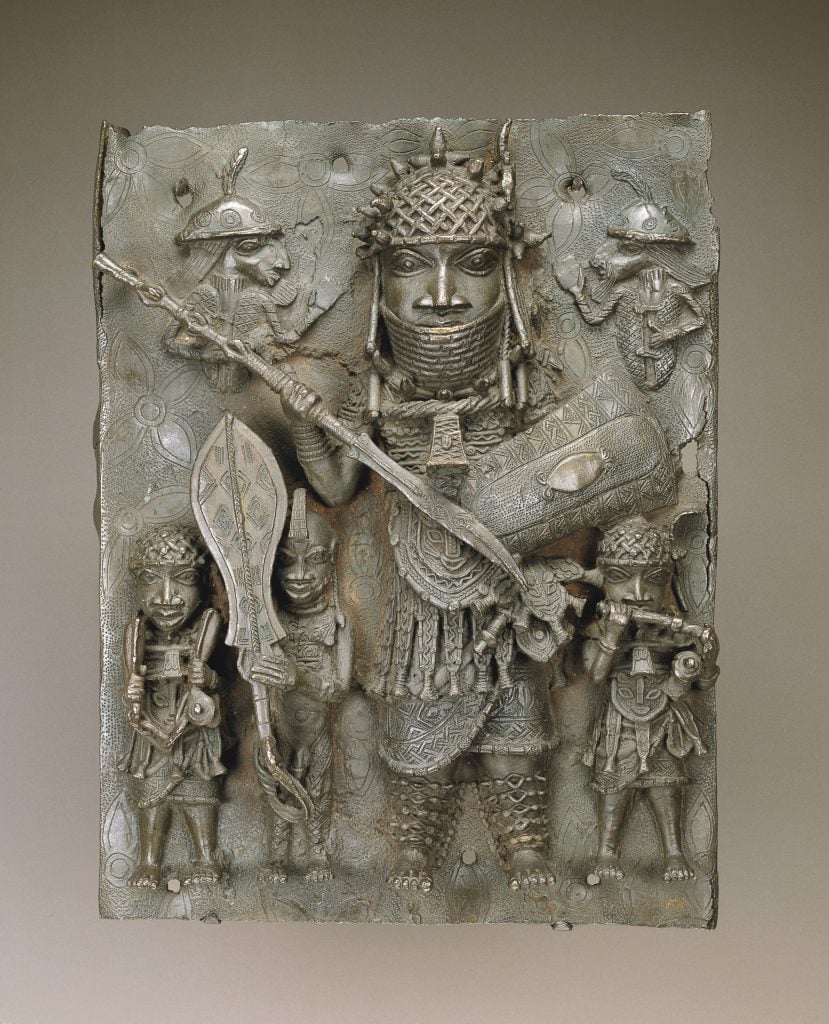
A Benin plaque from the mid-16th to 17th centuries. Courtesy of the National Museum of African Art.
However, that doesn’t necessarily mean that restitution is imminent. A spokesperson for the Smithsonian clarified that while the museum “is committed to repatriation”, the process—which would require the museum to research the provenance of the objects in question, have them appraised by outside experts, and negotiate a return—has only just begun.
“These Benin Bronzes are high-value objects and deaccessioning them will require approval from the Smithsonian Secretary and the Smithsonian’s board of regents,” the representative said. “When the process is complete, the Smithsonian will consider returning artifacts to their original home if requested.”
“That does not mean we are not committed to fixing this,” Blankenberg added in an email to Artnet News, “but rather that we need to make sure we have a thoughtful and effective process so that doing the right thing is an institutional, not individual practice.”
“It is very important for us at NMAFA that the Benin Bronze process be seen within a much wider context and strategy,” she continued. “Our process of trust-building with African and African diasporic peoples starts with decolonization—proactively evaluating the impact of unequal power relations in our sector, looking carefully and in many instances changing how we hire, document, conserve, interpret, program—and yes it may also include repatriation.”
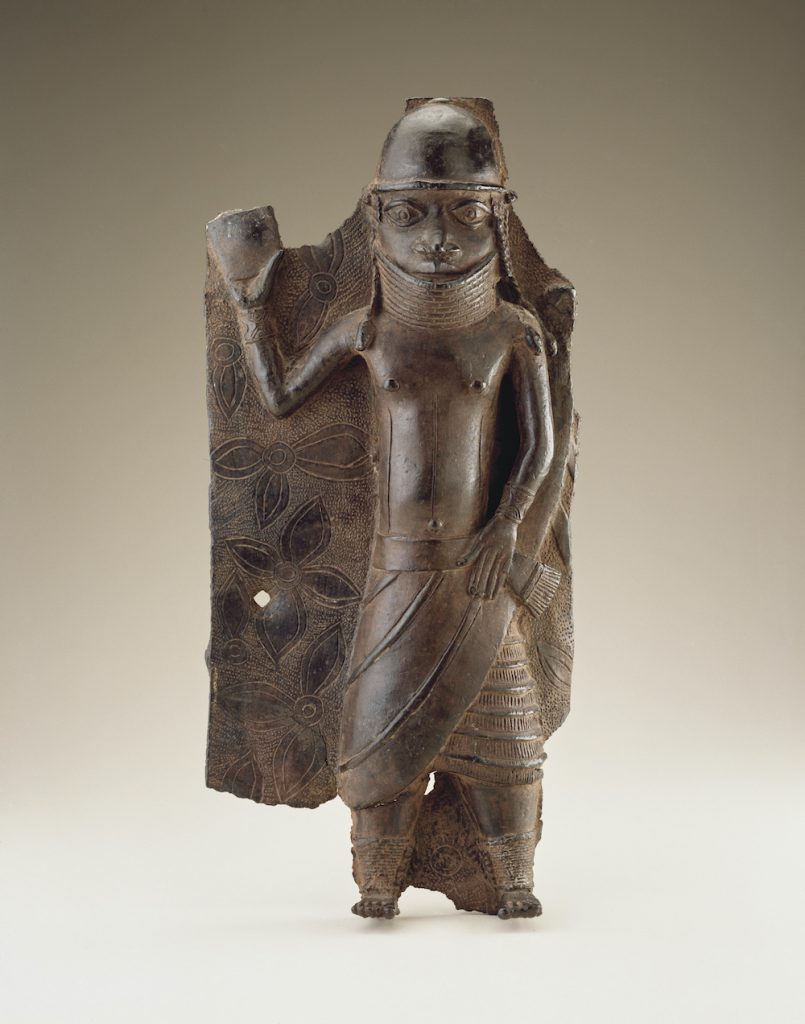
A Benin plaque from the mid-16th to 17th
centuries. Courtesy of the National Museum of African Art.
This May, following Germany’s landmark announcement that it would begin to restitute Benin bronzes as soon as 2022, Artnet reported that the NMAFA had no plans to return its collection of works from Benin.
“The museum has had a strong relationship with Oba and members of the royal court of Benin over the years,” NMAFA deputy director Christine Kreamer said at the time. “They are aware of the objects in our collection and appreciate that we continue to tell the story about how the kingdom’s treasures were looted from the palace in 1897.” A representative added that the museum had “not received a request for repatriation of objects.”
In recent years, the Benin bronzes have emerged as a central symbol in the larger debate about the restitution of cultural heritage obtained during periods of colonization. An estimated 3,000 bronzes taken from Benin are currently dispersed among more than 160 museums around the world.
But those numbers are slowly starting to decrease as various institutions and governing bodies have either returned objects to Africa or pledged to do so soon.
Last month, for instance, the University of Aberdeen and Jesus College at the University of Cambridge became the first two U.K. institutions to officially restitute bronzes, while in June, the Metropolitan Museum of Art in New York announced its own plans to return a pair of Benin plaques.
Follow Artnet News on Facebook:
Africa's lost heritage and Europe's restitution policies
France is returning artworks acquired in colonial times to Benin. Germany is also open to restitutions. How are other European countries addressing the issue?
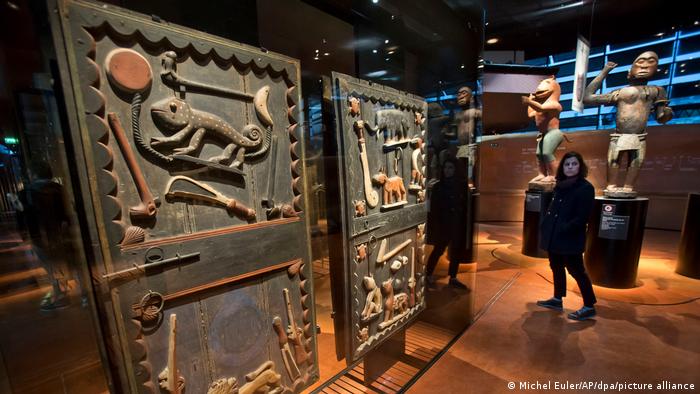
FRANCE RETURNS COLONIAL LOOTED ART TO BENIN
A special exhibition in Paris
Nearly 130 years after they were added to France's collection, the artworks are now being returned to Benin, in West Africa. Before their restitution, the works from the former Kingdom of Dahomey (located within present-day Benin) were on display in a special exhibition in Paris from October 26-31.
123456789
They are works of art of great symbolic value — intricately carved thrones, richly decorated doors and impressive statues.
Each of the statues, for example, is a symbolic representation of a monarch of the former kingdom of Dahomey: King Glele as a lion-man or King Behanzin, the last to rule over the kingdom before French colonization, as half-human, half-shark.
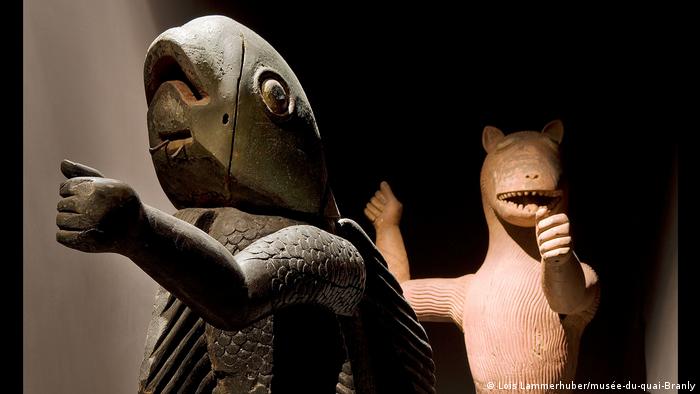
26 works are being returned to Benin
In a symbolic act, France is now returning these objects to Benin in West Africa, where the former kingdom of Dahomey was located. It is the first significant return by France to its former colony since it gained its independence in 1960.
"It's a historic moment for both countries," art historian and entrepreneur Marie-Cecile Zinsou told DW. Zinsou is president of the Zinsou Foundation, which promotes contemporary art in Africa and leads cultural and educational initiatives. In 2014 she also opened the first museum for contemporary art in Benin.
She has been closely following the current restitution process. "I am very proud, as a citizen of both France and Benin, to witness an intelligent dialogue that has long been unbalanced."
Changing mindsets throughout Europe
The European museum landscape is now being reshaped, but it has been an arduous process to get Europe to accept even discussing the issue in the first place.
Like Benin, many African states have been fighting for more than a century for the return of their artifacts stolen during colonial times.
The most prominent examples are the pieces known as the Benin Bronzes, from today's Nigeria.
Germany's Prussian Cultural Heritage Foundation retains the second largest collection of these priceless bronzes, which were stolen in 1897 by British soldiers from the royal palace in Benin City, in the north of what is now Nigeria.
At the beginning of the year, Germany agreed to return important pieces from its collection to Nigeria in 2022.
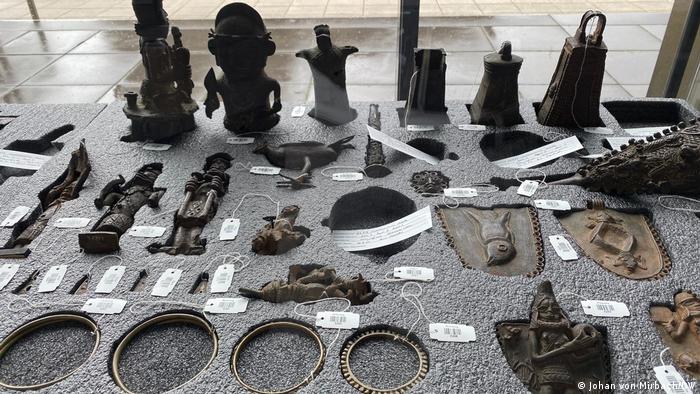
The works known as the Benin Bronzes are actually artifacts made of brass and ivory
The Netherlands is also willing to return items acquired through inequitable conditions.
At the beginning of the year, Belgium returned some important artworks taken during the colonial era, transferring ownership rights from Tervuren's Royal Museum for Central Africa to the Democratic Republic of the Congo.
"The situation in Europe and Africa is developing very quickly," notes art historian Zinsou.
In addition to restitution, she points out another notable development: the targeted reconstruction of collections in the countries of origin: "In Kinshasa, they are reflecting on what they have in their national collection, how they show their history and what is missing. And if there are missing pieces that have been identified in European collections, then they recreate them, by asking for information on these pieces," says Zinsou.

Marie-Cecile Zinsou is the daughter of Lionel Zinsou, former Prime Minister of Benin
Similar projects are taking place in Gabon, she adds — a demonstration of new approaches being developed, as Zinsou explains: "It's not about, 'Give us everything back or we will wage war against you!' That's not what it's about at all. We are not into replaying history; we are engaging in the future."
For Bonaventure Ndikung, who will become the director of Berlin'sHaus der Kulturen der Welt (House of the World's Cultures) in 2023, the future needs to begin with reconciliation, and that requires apologies. "This is being done now and more will be done," says the Cameroonian art curator, referring to the current debates on restitution between Africa and Europe. "But these are just the first steps, we need to keep going."
Africa's lost heritage
Experts estimate that 80-90% of Africa's cultural heritage can be found in European museums, or rather in their storage. Only a fraction of their massive collections has ever been exhibited.
At the beginning of the 20th century in Europe, there was a trend of establishing so-called ethnological museums, not only in metropolises such as London, Paris and Berlin, but also in smaller cities such as the Linde Museum in Stuttgart.
There was a strong competition between ethnological museums to create the most impressive collections of artifacts. Adventurers, scientists, and missionaries all contributed to bringing pieces to Europe.
UK's guarded watch on colonial artifacts
Colonial officers also simply took items away from local populations. One well-documented case is of a drum known as the Ngadji, a sacred and revered object for the Pokomo tribe in Kenya. Despite their demands for restitution, it is still in the British Museum.
The London museum also houses the world's largest collection of Benin Bronzes. Nigeria has long been demanding the return of the artifacts, with a renewed official request placed in October 2021.
The British Museum's reply to DW's interview request came in the form of a short written statement: "The Museum understands and recognizes the significance of the issues surrounding the return of objects [...].We believe the strength of the British Museum collection resides in its breadth and depth, allowing millions of visitors an understanding of the cultures of the world and how they interconnect over time — whether through trade, migration, conquest, or peaceful exchange."
New museum spaces needed in Africa
British art historian John Picton, who worked for both the British Museum and the state museum commission in Nigeria, mentions one issue that has been repeatedly cited as a reason to retain the pieces, and that is "the lack of any facilities to actually properly house this material," he told DW. "I'm afraid I do take the view that simply to send it back with no concern for proper storage, security, conservation, climate control and what not, is simply irresponsible."
The new Edo Museum of West African Art is being built in Benin City, Nigeria, but it is far too small to be able to exhibit all the bronzes there, says Picton. He suggests that only the bronzes that are in the British Museum's storage should be returned, so that art from sub-Saharan Africa can still be seen in Great Britain.
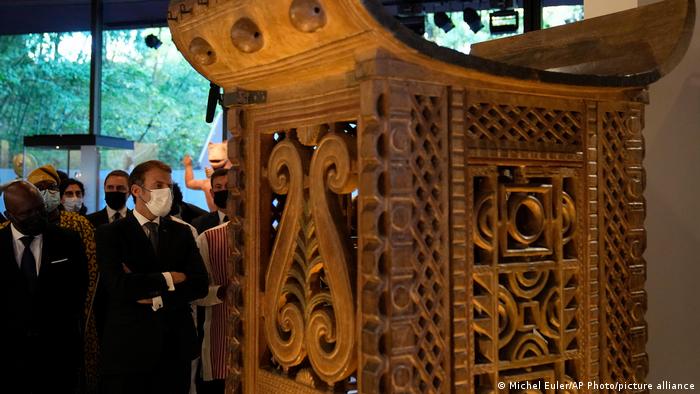
French President Macron next to the 19th-century Throne of King Ghezo, which now returns to Benin
A new museum is also being built in Abomey, the former royal city of today's Benin — for the artworks that are being returned from France.
People there are hoping that more returns will follow this first symbolic restitution by the former colonial power. Indeed, French President Emmanuel Macron has set up new laws requiring his country to return items that were unfairly acquired during the colonial era.
Nadir Djennad and Stefan Dege contributed to this article with interviews.
This article was translated from German.
France is returning artworks acquired in colonial times to Benin. Germany is also open to restitutions. How are other European countries addressing the issue?

FRANCE RETURNS COLONIAL LOOTED ART TO BENIN
A special exhibition in Paris
Nearly 130 years after they were added to France's collection, the artworks are now being returned to Benin, in West Africa. Before their restitution, the works from the former Kingdom of Dahomey (located within present-day Benin) were on display in a special exhibition in Paris from October 26-31.
123456789
They are works of art of great symbolic value — intricately carved thrones, richly decorated doors and impressive statues.
Each of the statues, for example, is a symbolic representation of a monarch of the former kingdom of Dahomey: King Glele as a lion-man or King Behanzin, the last to rule over the kingdom before French colonization, as half-human, half-shark.

26 works are being returned to Benin
In a symbolic act, France is now returning these objects to Benin in West Africa, where the former kingdom of Dahomey was located. It is the first significant return by France to its former colony since it gained its independence in 1960.
"It's a historic moment for both countries," art historian and entrepreneur Marie-Cecile Zinsou told DW. Zinsou is president of the Zinsou Foundation, which promotes contemporary art in Africa and leads cultural and educational initiatives. In 2014 she also opened the first museum for contemporary art in Benin.
She has been closely following the current restitution process. "I am very proud, as a citizen of both France and Benin, to witness an intelligent dialogue that has long been unbalanced."
Changing mindsets throughout Europe
The European museum landscape is now being reshaped, but it has been an arduous process to get Europe to accept even discussing the issue in the first place.
Like Benin, many African states have been fighting for more than a century for the return of their artifacts stolen during colonial times.
The most prominent examples are the pieces known as the Benin Bronzes, from today's Nigeria.
Germany's Prussian Cultural Heritage Foundation retains the second largest collection of these priceless bronzes, which were stolen in 1897 by British soldiers from the royal palace in Benin City, in the north of what is now Nigeria.
At the beginning of the year, Germany agreed to return important pieces from its collection to Nigeria in 2022.

The works known as the Benin Bronzes are actually artifacts made of brass and ivory
The Netherlands is also willing to return items acquired through inequitable conditions.
At the beginning of the year, Belgium returned some important artworks taken during the colonial era, transferring ownership rights from Tervuren's Royal Museum for Central Africa to the Democratic Republic of the Congo.
"The situation in Europe and Africa is developing very quickly," notes art historian Zinsou.
In addition to restitution, she points out another notable development: the targeted reconstruction of collections in the countries of origin: "In Kinshasa, they are reflecting on what they have in their national collection, how they show their history and what is missing. And if there are missing pieces that have been identified in European collections, then they recreate them, by asking for information on these pieces," says Zinsou.

Marie-Cecile Zinsou is the daughter of Lionel Zinsou, former Prime Minister of Benin
Similar projects are taking place in Gabon, she adds — a demonstration of new approaches being developed, as Zinsou explains: "It's not about, 'Give us everything back or we will wage war against you!' That's not what it's about at all. We are not into replaying history; we are engaging in the future."
For Bonaventure Ndikung, who will become the director of Berlin'sHaus der Kulturen der Welt (House of the World's Cultures) in 2023, the future needs to begin with reconciliation, and that requires apologies. "This is being done now and more will be done," says the Cameroonian art curator, referring to the current debates on restitution between Africa and Europe. "But these are just the first steps, we need to keep going."
Africa's lost heritage
Experts estimate that 80-90% of Africa's cultural heritage can be found in European museums, or rather in their storage. Only a fraction of their massive collections has ever been exhibited.
At the beginning of the 20th century in Europe, there was a trend of establishing so-called ethnological museums, not only in metropolises such as London, Paris and Berlin, but also in smaller cities such as the Linde Museum in Stuttgart.
There was a strong competition between ethnological museums to create the most impressive collections of artifacts. Adventurers, scientists, and missionaries all contributed to bringing pieces to Europe.
UK's guarded watch on colonial artifacts
Colonial officers also simply took items away from local populations. One well-documented case is of a drum known as the Ngadji, a sacred and revered object for the Pokomo tribe in Kenya. Despite their demands for restitution, it is still in the British Museum.
The London museum also houses the world's largest collection of Benin Bronzes. Nigeria has long been demanding the return of the artifacts, with a renewed official request placed in October 2021.
The British Museum's reply to DW's interview request came in the form of a short written statement: "The Museum understands and recognizes the significance of the issues surrounding the return of objects [...].We believe the strength of the British Museum collection resides in its breadth and depth, allowing millions of visitors an understanding of the cultures of the world and how they interconnect over time — whether through trade, migration, conquest, or peaceful exchange."
New museum spaces needed in Africa
British art historian John Picton, who worked for both the British Museum and the state museum commission in Nigeria, mentions one issue that has been repeatedly cited as a reason to retain the pieces, and that is "the lack of any facilities to actually properly house this material," he told DW. "I'm afraid I do take the view that simply to send it back with no concern for proper storage, security, conservation, climate control and what not, is simply irresponsible."
The new Edo Museum of West African Art is being built in Benin City, Nigeria, but it is far too small to be able to exhibit all the bronzes there, says Picton. He suggests that only the bronzes that are in the British Museum's storage should be returned, so that art from sub-Saharan Africa can still be seen in Great Britain.

French President Macron next to the 19th-century Throne of King Ghezo, which now returns to Benin
A new museum is also being built in Abomey, the former royal city of today's Benin — for the artworks that are being returned from France.
People there are hoping that more returns will follow this first symbolic restitution by the former colonial power. Indeed, French President Emmanuel Macron has set up new laws requiring his country to return items that were unfairly acquired during the colonial era.
Nadir Djennad and Stefan Dege contributed to this article with interviews.
This article was translated from German.
No comments:
Post a Comment